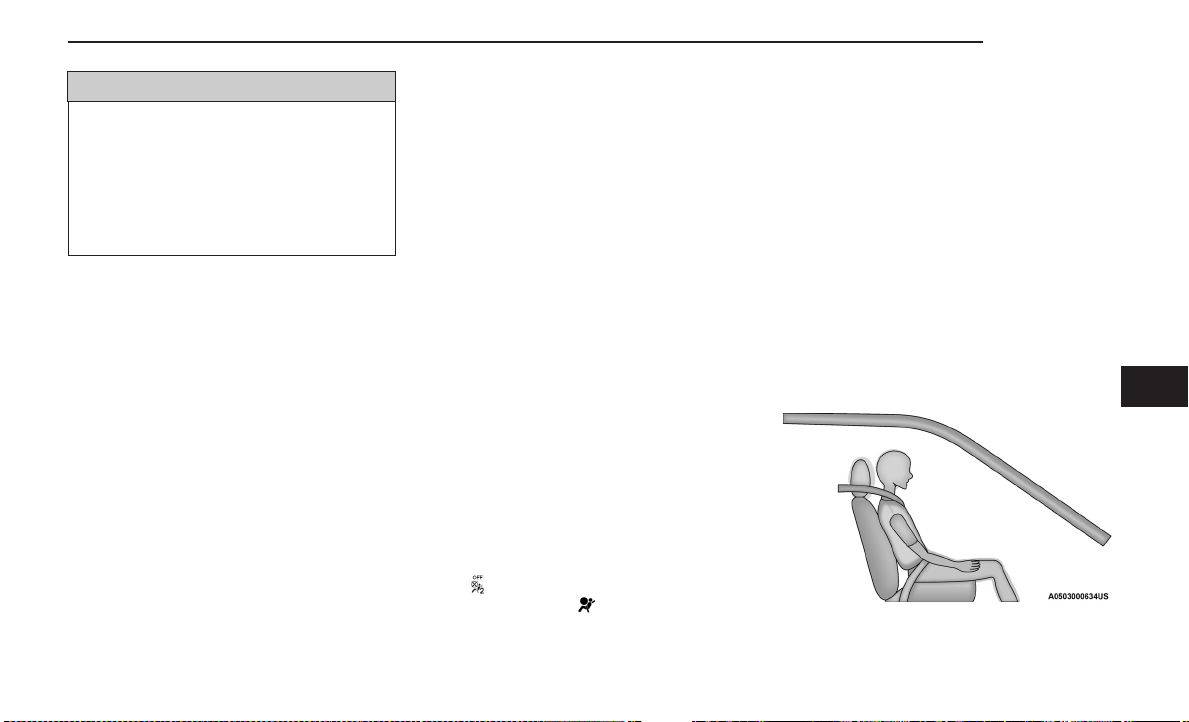Loading ...
Loading ...
Loading ...

WARNING!
because the air bags may no longer be functional.
The protective covers for the air bag cushions are
designed to open only when the air bags are
inflating.
•
Relying on the ai r bags alone could lead to more
severe injuries in a collision. The air bags work with
your seat belt to restrain you properly. In some col-
lisions, air bags won’t deploy at all. Always wear
your seat belts even though you have air bags.
Front Air Bag Operation
Front A ir Bags are designed to provide additional pro-
tection by supplementing the seat belts. Front air bags
are not expected to reduce t he risk of injury in rear,
side, or rollover collisions. The front air bags will not
deploy in all frontal collisions, including some that may
produce substantial vehicle damage — for example,
some pole co llisi ons, truck under ri de s, and angle offset
collisions.
On the other hand, depending on the type and location
of impact, front air bags may deploy in crashes with
little vehicle front-end damage but that produce a
severe initial deceleration.
Because air bag sensors measu re vehicle deceleration
over time, vehicle speed and damage by themselves
are not good indicators of whether or not an air bag
should have deployed.
Seat belts are necessary for your protection in all colli-
sions, and also are needed to help keep you in position,
away from an inflating air bag.
When the Occupant Restraint Controller (ORC) detects a
collision requiring the front air bags, it signals the infla-
tor units. A large quantity of non-toxic gas is generated
to inflate the front air bags.
The steering wheel hub trim cover and the upper pas-
senger side of the instr ume nt panel separate and fold
out of the way as the air bags inflate to their full size.
The front air bags fully inflate in less time than it takes
to blink your eyes. The front air bags then quickly
deflate while helping to restrain the driver and front
passenger.
Occupant Classification System (OCS) —
Front Passenger Seat
The Occupant Classifi cati on System (OCS) is part of a
Federally regulated safety system for this vehicle. It is
designed to activate or deactivate the Passenger
Advanced Front Air Bag depe ndi ng on the occupant’s
seated weight. It is designed to deactivate the Passen-
ger Advanced Front Air Bag for an unoccupied seat and
for occupants whose seated weight classifies them in a
category other than a properly seated adult. This could
be a child, teenager, or even an adult.
The Occupant Classification System (OCS) Consists Of
The Following:
•
Occupant Restraint Controller (ORC)
•
Occupant Classification Module (OCM) and Sensor
located in the front passenger seat
•
Passenger Air Bag Disabled (PAD) Indicator Light –
an amber light located on the overhead sports
bar
•
Air Bag Warning Light
•
Passenger Seat B e lt
Occupant Classification Module (OCM) And Sensor
The Occupant Classifi cati on Module (OCM) is located
underneath the front passenger seat. The Sensor is
located beneath the passenger seat cushion foam. Any
weight on the seat will be sensed by the Sensor. The
OCM uses input from the Sensor to determine the front
passenger’s most probable classi fic atio n. The OCM
communicates this information to the ORC. The ORC
uses the cla ssif icat io n to determine whether it should
activate or deactivate the Passenger Advanced Front Air
Bag. In order for the OCS to operate as designed, it is
important for the front passenger to be seated properly
and properly wearing the seat belt. Properly seated pas-
sengers are:
•
Sitting upright
•
Facing forward
•
Sitting in the center of the seat wi th their feet com-
fortably on or near the floor
•
Sitting with the ir back against the seat back and the
seat back in an upright position
Seated Properly
SAFETY 247
6
Loading ...
Loading ...
Loading ...